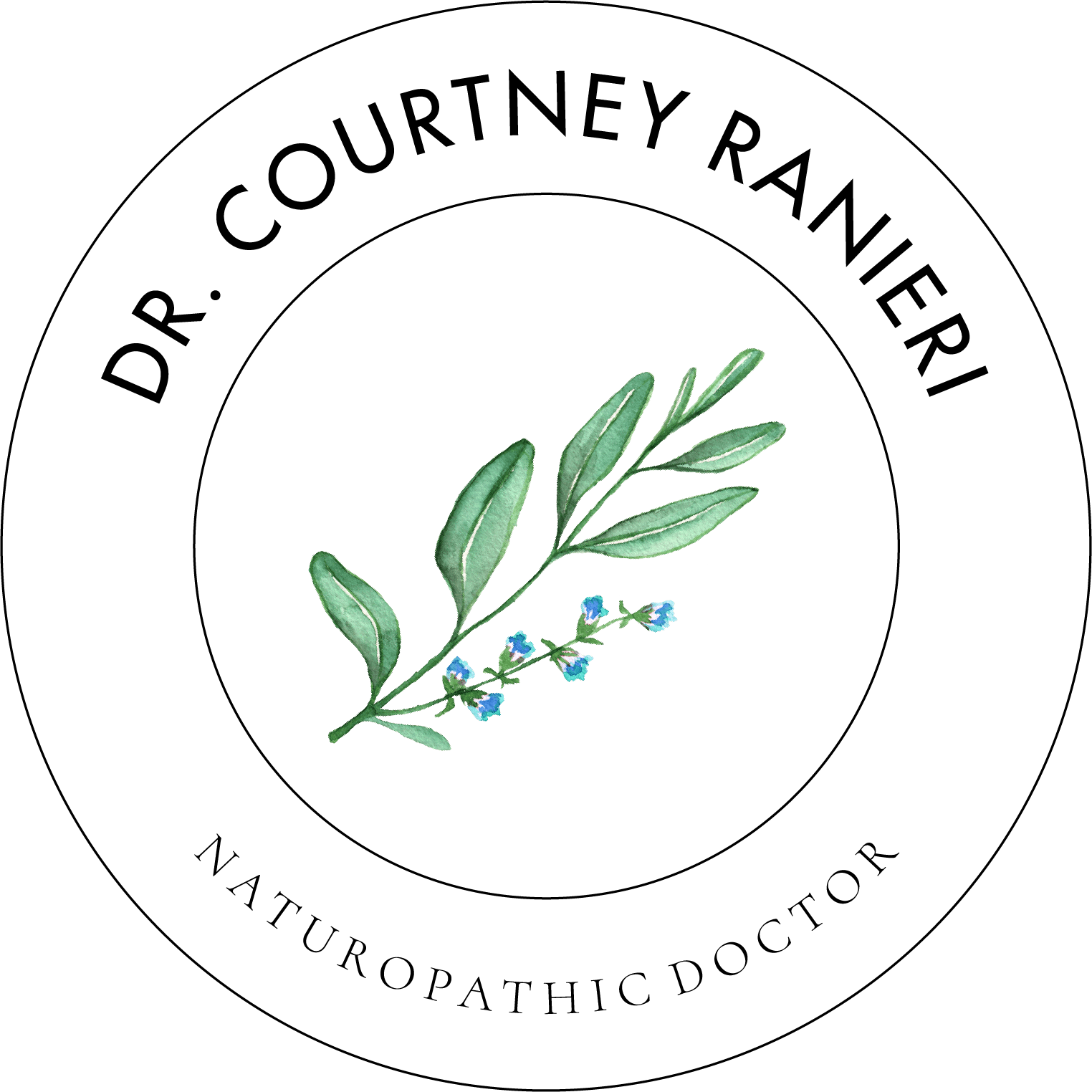Hormones + Fertility: 9 Ways to Minimize Your Environmental Exposure
In our modern world, environmental toxicants are everywhere.
As an ND who cares about helping patients’ optimize their hormones + fertility, I’m especially interested in ways that these environmental toxicants effect our mood, weight, energy and reproductive health. Read on to learn more about EDC’s and why and how to decrease our exposure.
What are EDC’s?
Studies suggest that environmental contaminants may have a big impact on hormones – these are called Endocrine Disrupting Chemicals or EDC’s. EDC’s are a group of substances that include certain pesticides, plastics, additives, preservatives and heavy metals like lead and mercury. Many EDC’s are stored in fat tissues tend to stay in our bodies for long periods of time.
Where are EDC’s found?
Around 800 chemicals are known or suspected to be endocrine disruptors.
Spoiler alert: we can potentially be exposed everywhere (including our water!).
Anything we interact with becomes a potential environmental exposure. Environmental exposures come from many different places – some you may not expect.
We are exposed to EDC’s from our foods, cosmetics, body-care products, household items (rugs, couches, paint etc), cleaning supplies, water, outdoor areas, farms – the list goes on!
One source of exposure that surprised me was receipts – yes the paper that you handle multiple times in a week (or day!). Receipts have been shown to be a major contributor to BPA (an EDC that can impact hormones like an estrogen in the body) in Canadians and according to Health Canada, 9 out of 10 Canadians have BPA in their bodies.
What Impact do EDC’s Have on Health, Hormones + Fertility?
Weight – A study found that in women who avoided foods, cosmetics, and products packaged in BPA-containing plastic containers for 3 weeks had a significant reduction in urinary levels of BPA. What is interesting is that over the study period (only 3 weeks!), the women who minimized BPA exposure also noted significant weight loss.
Infertility – Some studies reported associations between lead levels and unexplained infertility in women. Elevated levels of BPA were associated with increased risk of miscarriage. In women undergoing IVF treatments, elevated BPA has been associated with fewer eggs retrieved and lower estrogen levels.
Pregnancy – In pregnant women – elevated lead levels has been linked to gestational hypertension, low birth rate, miscarriage, impaired neurodevelopment and preterm delivery. Higher levels of phthalate in pregnant women (found in high levels in cosmetics, home products + more!) have been linked to decreased IQ in offspring.
Male Fertility + Sperm Production – New research by scientists at the University of Nottingham suggests that chemicals and environmental contaminants found in the home may be impairing hormone + sperm quality + quantity in men (+ this effect extends to male indoor dogs!).
Ovulation + Egg Quality – Studies suggest that Endocrine Disrupters may impact hormone function impair ovulation and egg quality in women.
PCOS + Endometriosis – For women with PCOS or endometriosis, increased levels of endocrine disruptors may also make these conditions worse.
Learn more about optimizing Preconception Health here.
Some Things to Watch Out For:
- Bisphenol’s (including BPA) – In Canada, bisphenol-A (aka BPA) has been banned in infant and baby products, but is still allowed to be used in other products. In addition, other forms of bisphenols like bisphenol-S are allowed and are suspected to have the same negative effects as BPA. They are mainly found in plastic products and food packaging (including tupperware and cans).
- Phthalates –Phthalates found in hundreds of products including fragrances, food and beverage containers, plastic wrap.
- Parabens – There is currently no regulation on the use of parabens in Canada. Parabens are used as preservatives in many cosmetic products and body-care products.
- Triclosan– Is a chemical found in many products to help kill bacteria. It is found in lotions, hand sanitizers, eye and face makeup, fragrances and deodorants, toothpaste and mouthwash, soaps, skin cleansers, and shampoos.
- Pesticides – Pesticides are used widely in food production. We are most often exposed to pesticides in the foods we eat.
9 Ways to Minimize Your Environmental Exposures
Our choices can have a major impact on helping us minimize these exposures.
If you’re feeling overwhelmed, a study of 100 teens found that after 3 days of avoiding cosmetics with phthalates, parabens and triclosan, they had a 30-45% reduction in urinary concentrations of these chemicals. This shows us that our choices absolutely have an impact on helping us minimize these exposures. Here are my top tips:
- Go organic (where it’s worth it!)
- Make the shift to ‘green’ home + body-care
- Read labels and try to avoid common EDC’s in home + body-care products such as phthalates, parabens and triclosan.
- Avoid any products with fragrances
- This is especially important if you have any hormonal conditions like PCOS, endometriosis, fibrocystic breasts, PMS, and before and during pregnancy
- Do not microwave food in plastic containers or plastic-wrap
- BPA exposure is increased by heating. It also increases with sunlight or acidic, salty or brined foods (such as tomatoes).
- Avoid putting plastic containers in the dishwasher
- Hand wash them when possible
- Store food in glass, porcelain or stainless steel containers
- Filter tap water
- Use stainless steel water bottles as opposed to plastic
- Avoid touching or handling thermal paper receipts
- Avoid #7 Plastics:
- How to check if a container contains BPA:
- Look for a 3-sided triangular arrow with a number in the centre (usually on the side or bottom).
- If the number is 7, your bottle may contain BPA.
If you are interested in optimizing your hormonal health, fertility + pregnancy support, I am a Naturopathic Doctor in Toronto, Mississauga and Vaughan. I have additional training in Integrative Fertility Methods and would love to help you reach your health goals.
In health,
Dr. Courtney Ranieri, ND
References
Canadian Association of Naturopathic Doctors. EnviroExposures. (2013). Retrieved 13 November 2019, from http://www.cand.ca/wp-content/uploads/2016/04/v20_i1_Spring2013_EnviroExposures_LR.pdf.pdf
Carnegie Mellon University. “Lead exposure found to affect fertility rates.” ScienceDaily. ScienceDaily, 22 May 2018. www.sciencedaily.com/releases/2018/05/180522123308.htm.
Bellinger, D. (2005). Teratogen update: Lead and pregnancy. Birth Defects Research Part A: Clinical And Molecular Teratology, 73(6), 409-420. doi: 10.1002/bdra.20127
Han, S., Pfizenmaier, D., Garcia, E., Eguez, M., Ling, M., Kemp, F., & Bogden, J. (2000). Effects of Lead Exposure before Pregnancy and Dietary Calcium during Pregnancy on Fetal Development and Lead Accumulation. Environmental Health Perspectives, 108(6), 527. doi: 10.2307/3454614
Han, S., Pfizenmaier, D., Garcia, E., Eguez, M., Ling, M., Kemp, F., & Bogden, J. (2000). Effects of Lead Exposure before Pregnancy and Dietary Calcium during Pregnancy on Fetal Development and Lead Accumulation. Environmental Health Perspectives, 108(6), 527. doi: 10.2307/3454614
Harley, K., Kogut, K., Madrigal, D., Cardenas, M., Vera, I., & Meza-Alfaro, G. et al. (2016). Reducing Phthalate, Paraben, and Phenol Exposure from Personal Care Products in Adolescent Girls: Findings from the HERMOSA Intervention Study. Environmental Health Perspectives, 124(10), 1600-1607. doi: 10.1289/ehp.1510514
Health Canada. (2019). Fourth Report on Human Biomonitoring of Environemntal Chemicals in Canada – Canada.ca. Retrieved 13 November 2019, from https://www.canada.ca/en/health-canada/services/environmental-workplace-health/reports-publications/environmental-contaminants/fourth-report-human-biomonitoring-environmental-chemicals-canada-page-3.html#a9-1
Common EDCs and Where They Are Found | Endocrine Society. (2019). Retrieved 13 November 2019, from https://www.endocrine.org/topics/edc/what-edcs-are/common-edcs
Pilsner, R., Hu, H., Ettinger, A., Sanchez, B., Wright, R., & Cantonwine, D. et al. (2009). Influence of Prenatal Lead Exposure on Genomic Methylation of Cord Blood DNA. Epidemiology, 20, S84. doi: 10.1097/01.ede.0000362961.55503.96
Preconception Care: A New Standard of Care within Maternal Health Services – Genuis – BioMed Research International
Segal, T., & Giudice, L. (2019). Before the beginning: environmental exposures and reproductive and obstetrical outcomes. Fertility And Sterility, 112(4), 613-621. doi: 10.1016/j.fertnstert.2019.08.001









